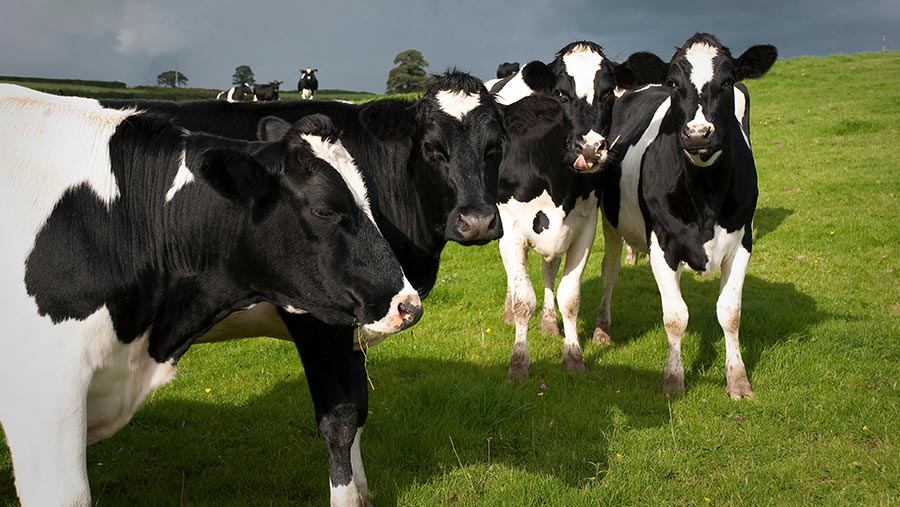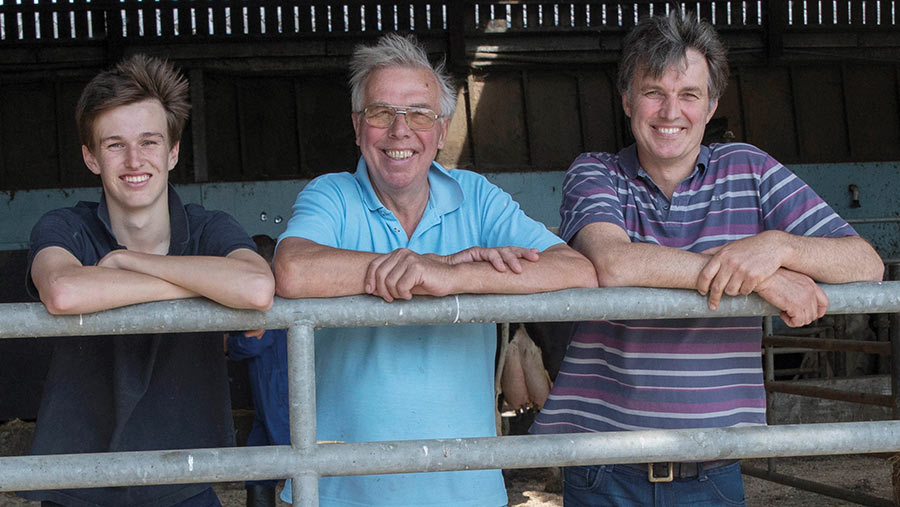Why genetics are critical for improving dairy cow fertility
 © Dariusz Gora/Adobe Stock
© Dariusz Gora/Adobe Stock Dairy cow fertility is at the heart of herd profitability, driving milk yields, cutting interventions and improving cow lifespans.
Evidence supporting the role of genetics in improving fertility has accumulated every year, and new data from AHDB are now strengthening this link (see graph below).
Since the introduction of the female fertility index (FI) in 2005, the genetics of fertility have shown massive improvement across the national dairy herd.
This is also reflected in actual performance, or phenotype, as well as the genetic prediction of calving index (also shown on the graph).
See also: Leeds leads latest bull rankings with £914 PLI
But today’s improvements follow years of decline when producers had little idea of a bull’s ability to transmit female fertility and were largely selecting for milk production.
This had the effect of not simply ignoring cow fertility, but positively selecting against it.
This was driven by the moderate negative correlation between milk production and fertility, which was known at the time, but was difficult to address.
However, today’s sophisticated computing power and genetic indexing system have turned this situation on its head.
And through the development of more holistic indexes, such as profitable lifetime index (PLI), which includes an element of fertility alongside other traits, it has been easy for producers to include fertility in their genetic selection criteria.
These indexes have also made it possible to ensure genetic choices made today do not have unintended consequences through correlations between desirable and undesirable traits, as was the case in the past.
Marco Winters, head of animal breeding for AHDB, says producers should be congratulated on achieving this turnaround.
Cut in calving interval
He says: “Their efforts have effectively cut average calving interval from a high of almost 425 days in the mid-2000s to nearer 395 days today.”
This progress was, in fact, predicted in an earlier genetic study about five years ago.
At that time AHDB forecast, from genetic trends, that the UK’s average calving interval would reach 390 days by 2024.
“With this projection still on target, it’s possible to confidently predict even more improvement ahead,” he says.
“This improvement will be slower, as we’ve taken the low-hanging fruit, but we expect to continue to cut calving interval by about one day every year over the next five years.”
This puts the national dairy herd on target for a calving interval of 385 days by 2029.
“This will bring us back to the fertility levels of the mid-1990s,” continues Marco. “But impressively, this has been achieved at the same time as milk yields have significantly climbed.”
Heritability of fertility
This achievement shows the power of genetics as a force for improvement. And it proves it is worth selecting even low-heritability traits.
“Fertility has a heritability of about 3% [or 0.03], which is considered to be low,” he says.
“However, heritability is the degree to which a trait is observed to be passed down the generations, and female fertility is highly influenced by environmental factors – ranging from nutrition and housing to the timing of insemination and the fertility of semen.”
The genetic indexing system is effective in filtering out this external “noise”, and pinpointing cows with an innate fertility.
“If we can measure cows’ inherent ability to get in-calf, it’s clear we can have a dramatic impact on animal performance,” he says.
Strongly urging every producer to consider FI, Marco says it should be a key part of all dairy breeding strategies.
“We need cows to get in-calf and we need them to last, and this index will help us achieve these goals.
“But fertility is also good for profit, welfare and the environment and for this reason, it’s included in all our major indexes including HealthyCow, EnviroCow and PLI, as well as both of the seasonal calving indexes.
“Of course, improved management can have a more immediate effect on dairy cow fertility, but improvements made through breeding will be sustained over the long term, and accumulate over generations,” he says.
“As with all traits, it’s important to consider both genetics and management, and to remember that having better genetics will make management easier.”
How to rank your herd for fertility
To check your own herd’s genetic merit for fertility, sign up for the AHDB Herd Genetic Report.
Most producers use this service through the AHDB website, where – as long as they are milk recorded – they can rank their own herd for many genetic traits, including fertility index.
This allows them to track progress over the generations and pick out animals that should have the best innate fertility and the ability to pass this on to the next generation.
To sign up, visit: ahdb.org.uk/herd-genetic-report-sign-up
Genetic workshops
Workshops are being held by AHDB across Britain through to 9 November, where dairy farmers and managers can learn more about unlocking their herd’s breeding potential.
They will help producers:
- Create clear breeding goals tailored to their own farm’s requirements
- Access and analyse their herd’s genetic potential with a personalised report
- Identify their herd’s baseline as well as areas for improvement
- Evaluate their own data and choose the right bulls for their herd.
For a list of dates and venues, visit: ahdb.org.uk/unlock-your-herd-s-hidden-breeding-potential
Essex dairy cuts calving index by 40 days
Farm facts: Battles Hall Farm, Essex
- 429ha
- Curtismill pedigree Holsteins, fully housed
- All-year-round calving
- Three-times-a-day milking
- Average yield 13,500 litres at 4% fat and 3.28% protein
- Milk sold to Muller

Rory, Robert and John Torrance © Jack Hill/the Times
Essex farmer and NMR/RABDF Gold Cup winner John Torrance was quick on the uptake when AHDB’s fertility index was introduced in 2005 and has been using it as a breeding tool ever since.
He says the index has transformed performance of his 700 cows, whose fertility has steadily improved for about 15 years, alongside greater production.
Calving index today is 40 days lower than it was at the outset, dropping from 420 to 380 days.
He says: “We’ve made giant strides since we began using the health indexes, and Oman bloodlines in particular have transformed health and fertility.”
He has complete confidence in the data and the choice of high daughter fertility bulls within the Holstein breed, adding: “The data doesn’t lie – before we had it, we were just choosing bulls on a whim.”
Also acknowledging the importance of activity monitors, he says they have played an important part, working in tandem with genetics.
Together, they have allowed the herd’s voluntary waiting period to be increased to 55 days, as John is more confident than ever of getting his cows in-calf.
Pregnancy rate bears out the success of the policy and now runs at a rolling average of 29.5%.
